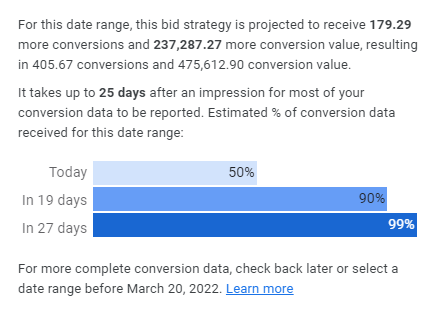How to optimize Smart Bidding in eCommerce campaigns

Content
Strategies for automated bidding use machine learning to optimize conversions or conversion value in each bid. To bid, algorithms "train" with large-scale data for more accurate estimates of the impact of various bid amounts on conversions or conversion values. These algorithms take into account a wide range of parameters that affect performance, more than one person or team could process.
Even in this context, where the algorithm is responsible for campaign performance, we can intervene with more than just a simple budget adjustment.
9 optimizations that can be made for Smart Bidding:
- Increase/ decrease Target ROAS
- Set multiple bidding strategies
- Give up on the target ROAS
- Temporarily change minimum bid
- Change the maximum bid
- Adjust according to seasonality
- Data exclusion
- Use Conversion Targeting
- Allocate time
How to use Impression Share metrics
Top Impression Share
This metric refers to the percentage of time that ads appear in the top 4 positions:
- <50% are underperforming positions
- 70-90% is an optimal percentage
- Anything under 100% means there is room to bid more
Absolute Top Impression Share
This metric refers to the percentage of time that ads appear in the first position:
- <10% is not good enough
- 50-80% is usually the optimal point
- 80-90% is very good
- 90-100% is rare and may mean overbidding
In any case, these metrics are supportive, ROAS being the one that will determine how much can be bid.
Do not ignore delayed conversions
Google Ads dates conversions on the days when clicks occurred, while in Google Analytics and in the backend we will see conversions on the day they occur.
The more expensive the products, the longer it will take for the buyer to decide.
If there are many delayed conversions, it should be taken into consideration to exclude the cost for the last 5-7 days when we examine performance.
Google Ads shows us how many more conversions can occur:

Also, we can see an estimate of the number of conversions that will occur by hovering over the blue bar.

9 optimizations that can be made for Smart Bidding:
1. Increase/ decrease Target ROAS
The most common and simple actions are the following:
- If a higher ROAS is desired, we will increase the target ROAS
- If a lower ROAS is not desired, we will decrease the target ROAS
Additionally, in order to obtain a higher ROAS, it is important to observe different scenarios in which we test the target ROAS. For example, if a cost of 10000 lei resulted in a ROAS of 800% and a profit of 80000 lei, we can test increasing the target ROAS to 800%. In this case, it is possible to achieve better results, for example the same profit but at a slightly lower cost.
When should we decrease the target ROAS?
- At the beginning of a peak season, to build traffic for products without results
- If the ROAS has recently decreased, but we want to maintain the same profit
How much should we increase/decrease the target ROAS?
Google's recommendation is to not change the ROAS by more than 20% per week. However, it's important to know that:
- If you want to change the target ROAS by more than 20%, it should be taken into account that it will significantly decrease spending as well. If you are time constrained, this could be the best option.
- The smaller the current target ROAS, the smaller the impact of changes will be on performance (for example from 200% to 160%).
Set multiple bidding strategies
In order to know if a correct target ROAS is set, it's important to work with different bid strategies. Savy Revenue recommends using between 2-5 different bidding strategies with varied targets for different purposes:

Give up on the target ROAS
Setting a target ROAS will constrain the results. For a stagnant account or at the start of a peak season, a good option is to remove the target ROAS. This will change the strategy to Maximize Conversion Value.
This strategy will 'free up' products that previously did not reach the set ROAS. Even though the ROAS was too low, we must take into consideration that the market and consumer needs are constantly changing.
Temporarily change minimum bid
Temporarily increasing the bid will reintroduce the products into the search terms. A good example in this situation is seasonality. Products such as swimsuits will perform poorly in winter. Therefore, a good practice is to lower the ROAS in the spring so that we 'free up' the restricted products.
A downside to this optimization strategy is that the rule will apply to everything, and the bid will increase both for the 'inactive' products and the others. That is why it is important to set up more bidding strategies.
Change the maximum bid
This is rarely necessary, but if maximum bids are used in Smart Bidding strategies, it is good to check if the campaigns are limited by them.
Adjust according to seasonality
We can adjust the bid according to seasonality when lower or higher conversion rates are expected than in the previous period, but only temporarily, for a period of 1-7 days.
- Before/ after a major promotion
- During a period (holidays) when a lower conversion rate is expected
- During stock changes on the website
7. Add data exclusions
Exclude data for a certain period of time that Smart Bidding should ignore when calculating the bid amount. This optimization strategy can be applied when:
- Tracking is not working
- Too many conversions are reported compared to real ones
- Massive sales campaigns have taken place
- Top 3 extremely poor performing days
- Top 3 very good performing days
8. Use Targeting Conversions
This strategy works better if you have less than 100-200 conversions per month or when the conversion value is very variable.
Allocate time
To be able to draw conclusions from the optimizations, it is important to give enough time for the campaigns to collect enough data.
What’s NOT recommended?
Do not cut the budget to increase the ROAS-ul
Campaigns should not be limited by budget. If you are consistently reaching the daily budget limit, it is recommended to switch the Smart Bidding strategy to Maximize Conversion Value.
Do not increase the minimum bid on long term
On the long term, it's not a good idea to increase the bid, as it is a big waste of budget. As mentioned, on the short term this optimization strategy will provide the advantage of reactivating products that haven't been successful due to a very low bid.
Therefore, even though Smart Bidding is an automated method, it's advisable to keep an eye on campaigns and constantly optimize them for the best performance.
We are always available for a consultation on how to optimize your smart campaigns and more.










